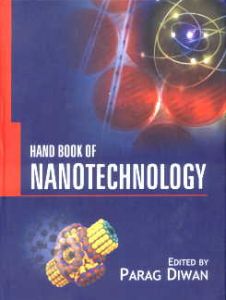
Contents: Preface. I. Nanotechnology Revolution: 1. Nanotechnology -- looking ahead. 2. The molecular world. 3. Bottom-up technology. 4. Fundamental issues of nanotechnology. 5. The threshold of nanotechnology. 6. Working with nanotechnology. 7. The spiral of capability. 8. Nanotechnology: fulfilling the basics. 9. Nanotechnology: aiding the environment. 10. Nanomedicine. 11. Limits and downsides. 12. Safety, accidents and abuse. 13. Nanotechnology: policy and prospects. 14. Nanotechnology era on the envil. 15. Space applications of molecular nanotechnology. 16. Introduction to fullerenes. 17. Geometry of fullerenes. 18. Nanotubes. 19. Applications of carbon nanotubes (Buckytubes). 20. Semiconductor superlattices. II. Nanostructured Materials: 1. Nanostructures materials -- an introduction. 2. Overview of semiconductors. 3. Semiconductor devices. 4. Semiconductor devices: transistor. 5. Semiconductor devices: diode. 6. Semiconductor devices: microprocessor and thermistor. 7. Semiconductor materials and spintronics. 8. Two-terminal, three-terminal, four-terminal semiconductor devices. 9. Basics of superconductors. 10. Types of superconductors. 11. Nanostructure science and technology: overview. 12. Synthesis and assembly of nanostructure materials. 13. Nanoparticulates: dispersions and coatings. 14. High surface area nanomaterials. 15. Functional nanoscale devices. 16. Bulk behaviour of nanostructured materials. 17. Biologically related aspects of nanoparticles, nanostructured materials and nanodevices. III. Nanocomposites: 1. Nanocomposites. 2. Nanomaterial additive. 3. Nanocomposite classification system. 4. Nanocomposites - applications. 5. Nanocomposites using plastics. 6. Nanocomposite's role in automotive and barrier packaging. 7. Nanocomposites improve package properties. 8. More application of nanocomposites. 9. Polymer nanocomposites. 10. Clay-Containing Polymeric Nanocomposites (CPNC). 11. Clay-based nanocomposites. 12. Polyolefin nanocomposites. 13. Polymer-silicate nanocomposites via melt compounding. 14. Dendrimer nanocomposites in medicine. 15. Nanoparticles. 16. Nanoparticles, nanotubes and nanocomposites. 17. More applications of nanoparticles. 18. Nanoart. 19. Nanocrystals. 20. Nanoclusters. 21. Current commercial applications of nanomaterials. IV. Nanoelectronics: 1. Nanoelectronics: introduction. 2. Nanoscale electronics. 3. A brief overview of nanoelectronic devices. 4. Quantum dots: an introduction. 5. Quantum dots: more details. 6. Resonant Tunneling Devices (RTDs). 7. Resonant Tunneling Device Logic Circuits. 8. Applications: nanodevices, nanoelectronics and nanosensors. 9. Nano-optics: introduction. 10. Wafer-level nano-optics. 11. Near-field optical microscopy. 12. Single carbon nanotube optical spectroscopy. 13. Optical processing. 14. Optoelectronic space applications. 15. Integrated optical circuits. V. Nanorobotics: 1. Introduction to Nanorobotics. 2. Nature's nanorobotic devices. 3. Nanorobotics design and control. 4. SPM and nanomanipulation. 5. Nanorobots: medicine of the future. 6. Nanorobots in the bloodstream -- The promise of nanomedicine. 7. Nanorobots in surgery. 8. Vasculoid -- a personal nanomedical appliance to replace human blood. 9. Vasculoid: physiological materials transport. 10. Biocompatibility of Vasculoid Systems. 11. Control systems and computational requirements and hypothetical vasculoid installation scenarios. 12. Vasculoid optional equipment. 13. NanoTribology. 14. Nanotribology: modeling atoms when surfaces collide. VI. Nanomedicine: 1. The prospect of nanomedicine. 2. Nanomedicine taxonomy. 3. Nanomedicine -- The Medical Revolution. 4. Nanosensors and nanoscale scanning. 5. Six opportunities in nano-enabled drug delivery systems. 6. Nano-enabled drug discovery: Seven technologies to watch. Appendices. Bibliography. Nanomedicine glossary. Index.
"One of the biggest scientific trends of the 21 century has been focused on something incredibly small: i.e. of the order of 10-9 metre. The word Nanotechnology means different things to different people. For some, it conjures up images of fabulour new materials, lighter and stronger than steel. Others envision microscopic robots that clean plaque for our arteries and tartar from our teeth. In the purest sense, nanotechnology is the science on small very small things measured in units called nanometers, which are one-billionth of a meter. In other words, a nanometer is so small that if one meter were stretched from Kashmir to Kanyakumari, each nanometer would still be the size of an aspirin. The foundations of nanotechnology have emerged over many decades of research in many different fields.
The Handbook of Nanotechnology seeks to explain this complex field and provide an understanding of what is happening now in the field, as well as what to expect in the short and long terms. The handbook consists of following distinct sections.
Section I: Nanotechnology Revolution delineates a number of alternative scenarios to develop our understanding of nanotechnology.
Section II: Nanostructured materials details recent advances in the synthesis and investigation of functional materials, focusing on the novel size-dependent physics and chemistry that results when atoms and electrons are confined within nanoscale semiconductors and metal clusters.
Section III: Nanocomposites provides a perfect insight into the latest technologies, emerging markets and commercial opportunities for nanocomposites.
Section IV: Nanoelectronics and nanoptics is a topic that is attracting a lot of interest in scientific and nonscientific corners alike. This enables readers to better understand drivers and demand patterns for nanoelectronics and nano-optical products, such as the trend in computing, communications, optical satellite telecommunications or sensor technology and IT.
Section V: Nanorobotics describes SPM principles, surveys SPM uses in Nanomanipulation and looks at the SPM as a robot.
Section VI: Nanomedicine touches upon some of the leading areas to which nanotechnology tools, materials, devices and intelligent materials and machines are currently applied in medical research.
This handbook provides details of this technology and further prospects as the technology improves, we will be able to move hundreds, thousands and then millions of atoms at will, to precisely construct objects of virtually any size, shape and material." (jacket)